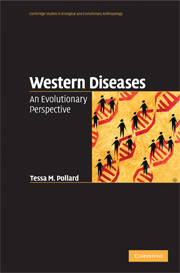Book contents
- Frontmatter
- Contents
- Preface
- 1 Introduction
- 2 An evolutionary history of human disease
- 3 Obesity, type 2 diabetes and cardiovascular disease
- 4 The thrifty genotype versus thrifty phenotype debate: efforts to explain between population variation in rates of type 2 diabetes and cardiovascular disease
- 5 Reproductive cancers
- 6 Reproductive function, breastfeeding and the menopause
- 7 Asthma and allergic disease
- 8 Depression and stress
- 9 Conclusion
- References
- Index
7 - Asthma and allergic disease
Published online by Cambridge University Press: 05 June 2012
- Frontmatter
- Contents
- Preface
- 1 Introduction
- 2 An evolutionary history of human disease
- 3 Obesity, type 2 diabetes and cardiovascular disease
- 4 The thrifty genotype versus thrifty phenotype debate: efforts to explain between population variation in rates of type 2 diabetes and cardiovascular disease
- 5 Reproductive cancers
- 6 Reproductive function, breastfeeding and the menopause
- 7 Asthma and allergic disease
- 8 Depression and stress
- 9 Conclusion
- References
- Index
Summary
The rise of asthma and allergic diseases in most affluent countries of the world over the last 40 years has been striking, and many theories have been proposed to explain the phenomenon. These theories help us to understand what has gone wrong in our bodies when we have an allergic response to apparently harmless substances, such as cat dander, pollen or peanuts. Some of these ideas incorporate evolutionary insights, in particular, the suggestion that the human immune system is now lacking contact with organisms that would previously have had an important role in directing its development.
The scale of the problem
What is asthma?
The term asthma has usually been used to describe attacks of shortness of breath and wheezing caused by swollen and inflamed airways that are prone to constrict suddenly and violently. It is more commonly seen in children than in adults. However, there is increasing concern that the term is used to describe a range of conditions that do not necessarily share common underlying pathologies (Lancet Editorial 2006). There is no single biological marker or clinical test for asthma, and symptoms, triggers and responses to treatment are variable. The most common distinction is between allergic and non-allergic asthma, with allergic asthma being more common, particularly in children. But categorising a given case of asthma, even according to this broad dichotomy, can be difficult (Wenzel 2006).
- Type
- Chapter
- Information
- Western DiseasesAn Evolutionary Perspective, pp. 120 - 135Publisher: Cambridge University PressPrint publication year: 2008



